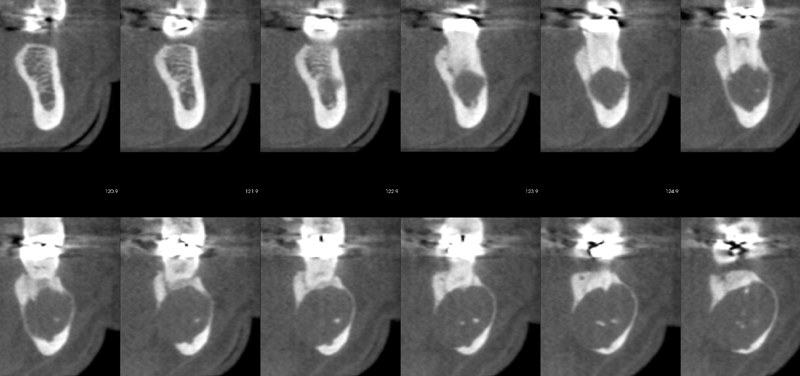Being that the two previous posts on radiographic entities either looked over or misdiagnosed created quite a few comments and questions, I have decided to make this a more regular series. The plan (as of now) is to post once a month on the first Wednesday of the month. This months case is a case of a misinterpretation.
Below are the cone beam CT images for this case. No patient information was provided with the images.
Reconstructed pantomograph showing well-defined, corticated, ovoid radiolucent area extending from mandibular left first molar to impacted third molar. There is thinning and inferior displacement of the inferior border of the mandible.
Cross-sectional slices near mandibular left first molar showing calcifications within the radiolucent lesion not visible on reconstructed pantomograph. There is thinning of the facial and lingual cortical plates with a discontinuity of the lingual cortical plate.
Initial interpretation: Based on the images above with the expansion / displacement of the cortical plates and multiple calcifications within the lesion, the initial interpretation had an odontogenic neoplasm such as a calcifying epithelial odontogenic tumor (CEOT) as the top possibility.
Histopathological Diagnosis: Periapical / Radicular cyst
Lesson learned: I was excited upon seeing the calcifications and automatically went to an entity (CEOT) which is must less common than a radicular cyst. This case is a good example of showing how a long standing cyst can have dystrophic calcifications occur within the entity. This is also where information about the teeth adjacent, such as tooth vitality may have changed the initial interpretation. I know its easy to go to the oddest and least common disease processes out there (students and faculty alike are all guilty of this); however there is a reason the saying ‘common things occur commonly’ is out there. This case was a good reminder to always go through common disease processes first before jumping to less common disease processes.
If you have any questions about either entity, please let me know. Thanks and enjoy!






Hi this might be a very very basic question but I still do what to understand the literal meaning of corticated border. I do know that the mandible is made of cortical bone. By corticated do we without any scalloping, well defined?
Cortical bone is the edge of a bone. When this is seen on a radiograph is shows that the lesion is separated from the surrounding bone. A corticated border will appear as a radiopaque border around a lesion or area in question. This radiopaque border will be well-defined and may be either a thin line or a thick line. Scalloping is more for a shape description. Please let me know if this helps. Thanks.